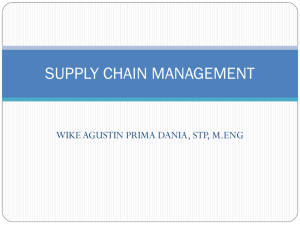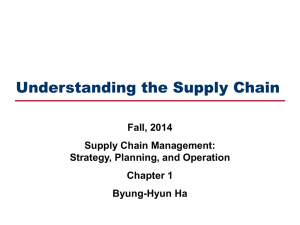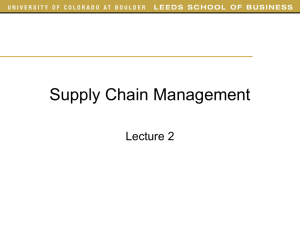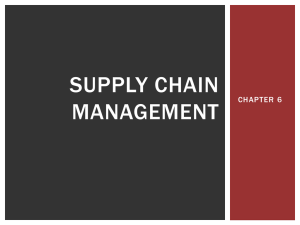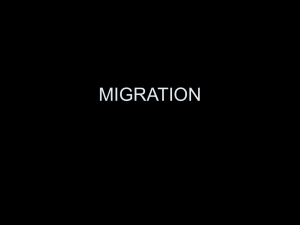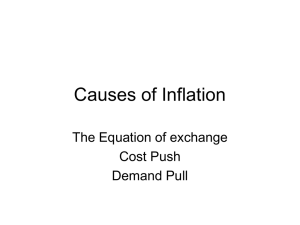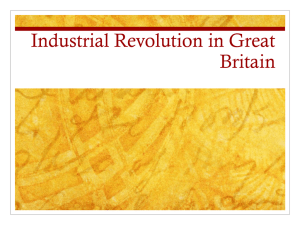Supply Chain - Decision Phases
advertisement
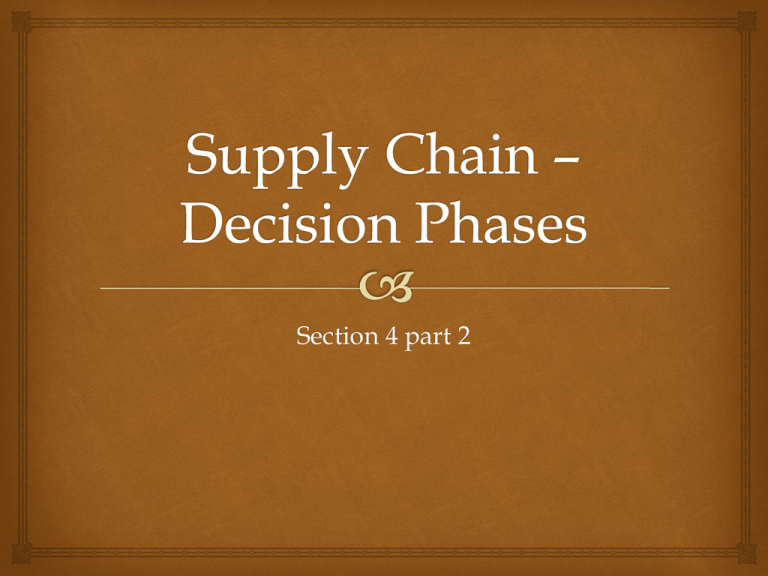
Section 4 part 2 The Magnitude In 1998, American companies spent $898 billion in supply chain related activities (or 10.6% of Gross Domestic Product) Third party logistics services grew in 1998 by 15% to nearly $40 billion It is estimated that the grocery industry could save $30 billion (10% of operating cost) by using more effective logistics strategies A typical box of cereal spends more than three months getting from factory to supermarket The Potential itself by changing its In 10 years, Wal-Mart transformed logistics system. It has the highest sales per square foot, inventory turnover and operating profit of any discount retailer Wal-Mart designed its supply chain with clusters of stores around distribution centers to facilitate frequent replenishment at its retail stores in a cost effective manner. Frequent replenishment allows stores to match supply and demand more efficiently than the competition. Wal-Mart has been a leader in sharing information and collaborating with suppliers to bring down costs and improve product availability. The results were impressive. The Impact In 1996, Dell held 31 days of inventory. It now holds only 4 days of inventory. The Impact The Turning Point (The Economist, 9/20/07) “For such a tiny part of GDP, the contents of warehouses has had a surprisingly big effect on its volatility. When industries cut or add stocks according to demand, that adjustment magnifies the effect of the initial change in sales. Stock levels were once much larger relative to the size of the economy, so a small slip in demand could easily blow up into a recession. But thanks to improvements in technology, firms now have timelier and better information about buyers. Speedier market intelligence and production in smaller batches allows firms to match supply to changing conditions. This makes huge stocks unnecessary and minimizes the lurches in inventories that were once so destabilizing. Study of Supply Chain Management Successful supply chain management requires decisions on the flow of information, product, and funds that fall into three decision phases Supply chain strategy or design Supply chain planning Supply chain operation TIME FRAME years 3 mo.- 1year daily Decision Phases in a Supply Chain TYPE Strategic Tactical Operational TYPICAL DECISIONS •Supply chain network design (How many plants? Location and capacities of plants and warehouses?) •Supply chain strategies (Sell direct or through retailers? Outsource or in-house? Focus on cost or customer service?) •Product mix at each plant •Workforce & Production planning •Inventory policies (safety stock level) •Which locations supply which markets •Transportation strategies •Production scheduling •Decisions regarding individual orders •Place replenishment orders Supply chain design, planning, and operation decisions play a significant role in the success or failure of a firm Supply chain strategy or design Supply chain planning Supply chain operation Supply chain design decisions are long-term and expensive to reverse – must take into account market uncertainty Supply chain planning decisions use a fixed supply chain configuration to come up with an overall production plan Supply chain operation makes decisions about individual customer orders & daily operations. Study of Supply Chain Management A supply chain is a sequence of processes and flows that take place within and between different stages Cycle view The processes in a supply chain are divided into a series of cycles, each performed at the interface between two successive stages of a supply chain Push/pull view The processes in a supply chain are divided into two categories depending on whether they are executed in response or in anticipation of a customer order Cycle View of Supply Chain Processes Customer Customer Order Cycle Cycle view defines the processes involved and the owner of each process Retailer Replenishment Cycle Distributor Manufacturing Cycle Manufacturer Procurement Cycle Supplier Subprocesses in Each Cycle Buyer Supplier markets the product Buyer may return the product Buyer places an order Supplier receives the order Buyer receives the order Supplier supplies the order Supplier Cycle View of Supply Chain Processes Customer Order Process 1. Customer Arrival Customer Order Cycle 2. Customer Order Entry 3. Customer Order Fullfillment 4. Customer Order Receiving Replenishment Cycle Manufacturing Process 1. Order Arrival 2. Production Scheduling 3. Manufacturing/Shipping 4. Receiving Replenishment Process 1. Retail Order Trigger 2. Retail Order Entry 3. Retail Order Fullfillment 4. Retail Order Receiving Manufacturing Cycle Procurement Cycle Procurement Process 1. Component Order Arrival 2. Production Scheduling 3. Manufacturing/Shipping 4. Receiving Differences 1.In the Customer Order Cycle demand is external 2.Scale (and frequency) of an order increases (decreases) when moving further away from the customer Each cycle occurs at the interface between two successive stages Customer order cycle (customer-retailer) Replenishment cycle (retailer-distributor) Manufacturing cycle (distributor-manufacturer) Procurement cycle (manufacturer-supplier) Push/Pull View of Supply Chain Processes PULL PROCESSES Execution is initiated in response to customer orders (reactive) Customer order arrives PUSH PROCESSES Execution is initiated in anticipation of customer orders (speculative) Processes are divided based on the timing of their execution relative to a customer order Processes are divided based on their timing relative to the timing of a customer order They key difference is the uncertainty during the two phases At the time of execution of a pull process customer demand is known At the time of execution of a push process customer demand is not known (and must be forecasted) Push/Pull Processes for the Supply chain of Dell PULL Customer Customer Order Cycle and Manufacturing Cycle Manufacturer PUSH Procurement Cycle Supplier Push/Pull Processes for the Supply chain of Detergent PULL Customer Customer Order Cycle Retailer Replenishment Cycle Distributor PUSH Manufacturing Cycle Manufacturer Procurement Cycle Supplier
